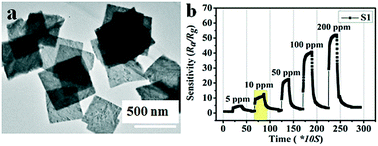Porous tungsten trioxide nanolamellae with uniform structures for high-performance ethanol sensing†
Abstract
Tungsten trioxide nanostructures have received considerable attention due to their enhanced gas sensing properties and promising applications in the sensing field. Herein, tungsten oxide (WO3) with a lamellar structure was prepared by a facile but feasible hydrothermal process and applied for gas detection. The structures, morphologies and surface characteristics of the as-obtained products were characterized by X-ray diffraction, X-ray photoelectron spectroscopy, scanning electron microscopy, transmission electron microscopy and Brunauer–Emmett–Teller analysis. The uniform nanolamellae were constructed from many substructures, primarily nanoparticles, resulting in desirable porous structures. To highlight the potential applications, gas sensors based on the as-synthesized products were fabricated to test their sensing performance. The test data indicated that the porous WO3 nanolamellae had superb kinetic response and remarkable selectivity towards some volatile organic compounds (VOCs), particularly ethanol, at an operating temperature of 200 °C. As such, we believe that these porous WO3 nanolamellae are promising as a potential high-performance sensing material for ethanol detection.


 Please wait while we load your content...
Please wait while we load your content...